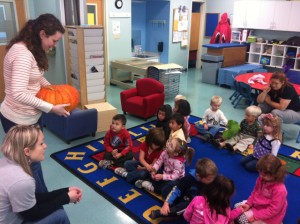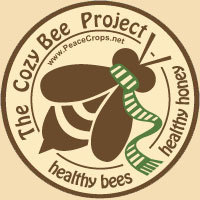 Since the very beginning of this venture, Emily has been dedicated to the idea of educational outreach as part of our mission. Today she put that into action at a local preschool in Tillamook, where she and a bunch of kids did a farm-to-food activity. She brought a pumpkin, pumpkin leaves, and pumpkin flowers for the kids to touch. As they were exploring, she explained to them how the pumpkin grows, and that you can eat it. They helped to pull the seeds out of the pumpkin, mashed some pumpkin chunks she precooked for them, and eventually eat pieces of pumpkin pie. They all seemed to have a really good time, and learn something in the process. I think programs like these are a great idea, to help kids know more about their food and where it comes from. From there, as they get older, they can progress to learning about how quality food affects their health and the health of their loved ones, and eventually to understanding the complex interactions that pesticides, monoculture, and genetically modified foods have on the overall food chain. And dare I hope, maybe some of them will even grow up to be lawyers, politicians, and scientist who can do something about it.
Since the very beginning of this venture, Emily has been dedicated to the idea of educational outreach as part of our mission. Today she put that into action at a local preschool in Tillamook, where she and a bunch of kids did a farm-to-food activity. She brought a pumpkin, pumpkin leaves, and pumpkin flowers for the kids to touch. As they were exploring, she explained to them how the pumpkin grows, and that you can eat it. They helped to pull the seeds out of the pumpkin, mashed some pumpkin chunks she precooked for them, and eventually eat pieces of pumpkin pie. They all seemed to have a really good time, and learn something in the process. I think programs like these are a great idea, to help kids know more about their food and where it comes from. From there, as they get older, they can progress to learning about how quality food affects their health and the health of their loved ones, and eventually to understanding the complex interactions that pesticides, monoculture, and genetically modified foods have on the overall food chain. And dare I hope, maybe some of them will even grow up to be lawyers, politicians, and scientist who can do something about it.

In other news, our garden is winding down. We’ve cleared what was left of the squash, corn, cucumbers, and so forth; we’ve also harvest the next-to-the-last of the pumpkins. But we’re not done! The farming is never done.
We’re already looking forward to next season. We’re going to double our acreage for vegetables, and that means a lot more machete-and-hoe time. Some plants for next year actually have to go in right now (who knew?), like the garlic. We bought some Spanish Rojo garlic from the organic farm store, and we’re interested in trying that, but the real score is two varieties of heirloom garlic we got from our friends Anthony and Victoria. They’re a nice couple in their 70s that we hang out with regularly. They’re been planting garlic for decades, and these are special strains they’ve carefully cultivated for flavor, size, and general awesomeness. They kindly sold us enough to plant both soft neck and hard neck to get us through an entire year, as well as having enough left over to plant THAT the following year. We’re pretty excited about it.
Besides garlic, it’s also strawberry season. We planted 150 square feet of two different types. The first is “Hood,” a strawberry generally accepted as being the best tasting the Northwest has to offer. It’s junebearing, so we will get a pile of them all at once, leading to both a feeding frenzy and a fierce jam-making campaign. The second is “Albion,” a berry that is tasty in its own right, but has the advantage of being everbearing, meaning snacking goodness all season long. And by all season, I mean ALL season… the seedlings we bought had a few berries still on them, and they were marvelous. Our newly planted strawberries will overwinter in their cozy bed, getting set up to grow explosively in the spring and give us pounds of red goodness.

